|
|
INDONESIA: 11.04. - 05.06.2005
Route: Sumatra (Belawan, Medan, Bukit Lawang, Medan, Berastagi,
Parapat, Tuk Tuk, Tarutung, Bukittinggi, Lake Manijau, Padang), Java
(Jakarta, Yogyakarta, Borobudur, Yogyakarta, Solo, Cemoro Lawang (Mt.
Bromo), Bayuwangi), Bali (Lovina, Tulamben, Padangbai), Lombok
(Lembar, Marakan, Gilli Air, Senaru, Mt. Rinjani, Matabar, Lembar), Bali
(Ubbud, Denpasar, Kuta)
Distance: 2485 Km Ascent (in total): 13765m
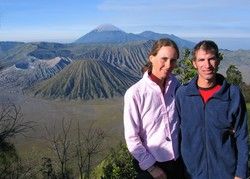 Preface: Cycling is definetely not the
best way for exploring Indonesia. On one hand, Indonesia is much to
big too visit it on a bycicle with the available two months visa,
and on the other hand, the traffic is pretty dangerous. In total,
we had two accidents and many "almost accidents". Despite of the city
state Singapore, Indonesia is we only country, in which we didn't
sleep in our tent. Especially on Sumatra, we didn't feel really comfortable.
Three times some guys threw stones to us, and up to 20 times a day
guys shoutet "fuck you" to us. At least at the touristy places the
people were much friendlier than in the rest of Sumatra (normally
vice versa). The inhabitants of Java, Bali and Lombok were again quite
friendly, so that we were able to enjoy our trip. The landscape in
Indonesia, and especially the volcanoes are absolutely worth a visit. Preface: Cycling is definetely not the
best way for exploring Indonesia. On one hand, Indonesia is much to
big too visit it on a bycicle with the available two months visa,
and on the other hand, the traffic is pretty dangerous. In total,
we had two accidents and many "almost accidents". Despite of the city
state Singapore, Indonesia is we only country, in which we didn't
sleep in our tent. Especially on Sumatra, we didn't feel really comfortable.
Three times some guys threw stones to us, and up to 20 times a day
guys shoutet "fuck you" to us. At least at the touristy places the
people were much friendlier than in the rest of Sumatra (normally
vice versa). The inhabitants of Java, Bali and Lombok were again quite
friendly, so that we were able to enjoy our trip. The landscape in
Indonesia, and especially the volcanoes are absolutely worth a visit. |
| |
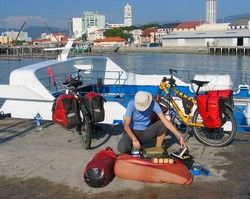 Boat trip: Indonesia consists of several
Islands, so we had to travel by a ferryboat from Georgetown (Malaysia)
to enter the country. When we bouht our ferry ticket we were told,
that there is no extra charge for the bicycles. When we picked up
our tickes on the day of departure, we were suddenly told, that there
was an extra charge for the bikes. Normally no problem, but we had
already spent our last money just a few minutes earlier! We had a
hard discussion with the travel agent (who sold us the ticked an who
had told us, that there is no extra charge), and finally, he gave
us the money for the bike ticket out of his commision. Loading the
bikes on the boat was no problem at all, and some hours later, we
arrived in Belawan, the port of Medan. Boat trip: Indonesia consists of several
Islands, so we had to travel by a ferryboat from Georgetown (Malaysia)
to enter the country. When we bouht our ferry ticket we were told,
that there is no extra charge for the bicycles. When we picked up
our tickes on the day of departure, we were suddenly told, that there
was an extra charge for the bikes. Normally no problem, but we had
already spent our last money just a few minutes earlier! We had a
hard discussion with the travel agent (who sold us the ticked an who
had told us, that there is no extra charge), and finally, he gave
us the money for the bike ticket out of his commision. Loading the
bikes on the boat was no problem at all, and some hours later, we
arrived in Belawan, the port of Medan. |
| |
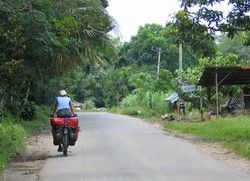 Bukit Lawang: From Medan, we cycled the
95 Km to Bukit Lawang, a small village famous for its Orang Utans.
Already during the last 25 Km, we had some guys with their mopeds
next too us, who tried to arrange a guesthouse or a jungle tour for
us. It was quite hilly and it was about 35°C hot with a humidity of
nearly 100% and therefor a real pain with the guys, but finally we
managed to get rid of them. During a big flood in 2003 most of the
houses and guesthouses in Bukit Lawang were washed away. It took us
some time to find a nice questhouse, but it was on the other side
of the river and we had to push our bikes over a shaky suspension
bridge. During the next days we heard more about Bukit Lawangs fate.
Due to illegal deforestation they had some erosion problems in the
recent years. After some heavy rainfalls, a big flood came and washed
everything away, and many people died or lost their whole existence.
Because of the lack of accommodation the tourist season in 2004 was
very poor, and after the Tsunamy and the earthquakes, there are nearly
no tourists on Sumatra any more. Although the governmet is building
new houses for the families, with no tourists it will become nearly
impossible for the Bukit Lawang to recover. Bukit Lawang: From Medan, we cycled the
95 Km to Bukit Lawang, a small village famous for its Orang Utans.
Already during the last 25 Km, we had some guys with their mopeds
next too us, who tried to arrange a guesthouse or a jungle tour for
us. It was quite hilly and it was about 35°C hot with a humidity of
nearly 100% and therefor a real pain with the guys, but finally we
managed to get rid of them. During a big flood in 2003 most of the
houses and guesthouses in Bukit Lawang were washed away. It took us
some time to find a nice questhouse, but it was on the other side
of the river and we had to push our bikes over a shaky suspension
bridge. During the next days we heard more about Bukit Lawangs fate.
Due to illegal deforestation they had some erosion problems in the
recent years. After some heavy rainfalls, a big flood came and washed
everything away, and many people died or lost their whole existence.
Because of the lack of accommodation the tourist season in 2004 was
very poor, and after the Tsunamy and the earthquakes, there are nearly
no tourists on Sumatra any more. Although the governmet is building
new houses for the families, with no tourists it will become nearly
impossible for the Bukit Lawang to recover. |
| |
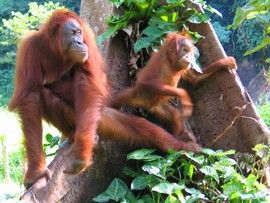 Orang Utan Center: The main tourist attraction
of Bukit Lawang is the BOHOROK ORANG UTAN REHABILITATION CENTER. Already
in the center we saw two female Orang Utans, playing around with their
babys. Together with two rangers, we followed a narrow steep and slippery
path into the jungle. After 20 Minutes, we reached the feeding platform,
some wooden boards between the trees. Just some minutes later, the
first Orang Utans arrived. In total four female Orang Utans with their
babys and two male Orang Utans came to the platform for the free bananas
and some milk. It was great to see, how save, elegant and silent the
Orang Utans managed to swing from tree to tree. It also was very fascinating
to see the humanlike behaviour ot the Orang Utans: each Orang Utan
didn't believe, that the bananas were finished, until it had inspected
the rucksack of the rangers with its own eyes. Orang Utan Center: The main tourist attraction
of Bukit Lawang is the BOHOROK ORANG UTAN REHABILITATION CENTER. Already
in the center we saw two female Orang Utans, playing around with their
babys. Together with two rangers, we followed a narrow steep and slippery
path into the jungle. After 20 Minutes, we reached the feeding platform,
some wooden boards between the trees. Just some minutes later, the
first Orang Utans arrived. In total four female Orang Utans with their
babys and two male Orang Utans came to the platform for the free bananas
and some milk. It was great to see, how save, elegant and silent the
Orang Utans managed to swing from tree to tree. It also was very fascinating
to see the humanlike behaviour ot the Orang Utans: each Orang Utan
didn't believe, that the bananas were finished, until it had inspected
the rucksack of the rangers with its own eyes. |
| |
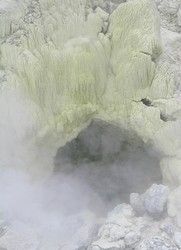 Berastagi and Mt. Sibayak: To reach Berastagi, our
next destination, we had to cycle up into the mountains, and with
1445m in altitude within 65 km, it was a very hard 6 tough stage.
We decided to climb Mt. Sibayak, with 2094m the smaller of the two
volcanoes of Berastagi. The ascent was quite easy, because 2/3 of
the path were paved and even the last stage wase made out of concrete.
The higher we climbed, the more it smelled like rotten eggs. On the
top we could finally see the reason: several huge hot steem fontains,
containing sulphur. In contrast to the ascent, the descent was
quite difficult: steep rotten stairs, slivery rocks and tracks with
some missleading junctions. According to the warnings of the guesthouses,
many tourist miss the path and have to stay over night in the jungle.
We had good luck and arrived save in the valley. Berastagi and Mt. Sibayak: To reach Berastagi, our
next destination, we had to cycle up into the mountains, and with
1445m in altitude within 65 km, it was a very hard 6 tough stage.
We decided to climb Mt. Sibayak, with 2094m the smaller of the two
volcanoes of Berastagi. The ascent was quite easy, because 2/3 of
the path were paved and even the last stage wase made out of concrete.
The higher we climbed, the more it smelled like rotten eggs. On the
top we could finally see the reason: several huge hot steem fontains,
containing sulphur. In contrast to the ascent, the descent was
quite difficult: steep rotten stairs, slivery rocks and tracks with
some missleading junctions. According to the warnings of the guesthouses,
many tourist miss the path and have to stay over night in the jungle.
We had good luck and arrived save in the valley. |
| |
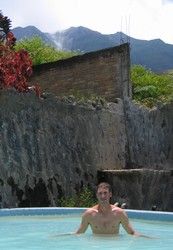 Hot springs: To relax, we jumped into some
hot thermal springs on the bottom of Mt. Sabayak. Although it was
rally relaxing for our aching muscles, we couldn't stay to long in
the water, because it contained too much like sulphur (smelled like
rotten eggs). Because our muscles are only used to cycle and not to
walk, we had some heavy aching muscles during the next days. Hot springs: To relax, we jumped into some
hot thermal springs on the bottom of Mt. Sabayak. Although it was
rally relaxing for our aching muscles, we couldn't stay to long in
the water, because it contained too much like sulphur (smelled like
rotten eggs). Because our muscles are only used to cycle and not to
walk, we had some heavy aching muscles during the next days. |
| |
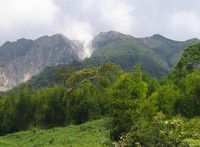 Earthquake: In the middle of the night, our bed started
to shake so strong, that we both awoke. We went immediately to the
rooftop terrace in front of our room, but the earthquake stopped after
about 30 seconds. During the next day many Indonesians told us, that
they are very afraid of earthquakes, and some even bury guardian items
in their gardens. For sure a bit too scared are some Indonesians at
Lake Toba. Although Lake Toba is on an altitude of 900m and sourounded
by high mountain, some people are afraid of being hurt by a tsunami! Earthquake: In the middle of the night, our bed started
to shake so strong, that we both awoke. We went immediately to the
rooftop terrace in front of our room, but the earthquake stopped after
about 30 seconds. During the next day many Indonesians told us, that
they are very afraid of earthquakes, and some even bury guardian items
in their gardens. For sure a bit too scared are some Indonesians at
Lake Toba. Although Lake Toba is on an altitude of 900m and sourounded
by high mountain, some people are afraid of being hurt by a tsunami! |
| |
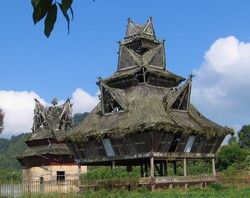 The Karo culture: The region around Berastagi is home
of the Karo. To survive in the mountais, the Karo had a very unique
way of living. The Karo built huge houses with 6 rooms. Each room
was inhabited by one family (in total up to 40 people). Each family
had a special funtion in this small community. One family was the
family of the chief and there was also the familie of the deputy (the
woman in this familiy was the sister of the chief).Then there was
the magic family, which had to look for the best date for seeding,
harvesting, marriage, ... . Another family had to take care of the
house, and the job of one family was the cooking. Bad luck had the
husbandof the 6th family, because he was not allowed to speak anybody
who was not living in the house, accept if he was expicit asked to
do so. Unfortunately also on Sumatra the things are changing, and
since the last Karo house was built in 1943, this way of living now
only exists in books. The Karo culture: The region around Berastagi is home
of the Karo. To survive in the mountais, the Karo had a very unique
way of living. The Karo built huge houses with 6 rooms. Each room
was inhabited by one family (in total up to 40 people). Each family
had a special funtion in this small community. One family was the
family of the chief and there was also the familie of the deputy (the
woman in this familiy was the sister of the chief).Then there was
the magic family, which had to look for the best date for seeding,
harvesting, marriage, ... . Another family had to take care of the
house, and the job of one family was the cooking. Bad luck had the
husbandof the 6th family, because he was not allowed to speak anybody
who was not living in the house, accept if he was expicit asked to
do so. Unfortunately also on Sumatra the things are changing, and
since the last Karo house was built in 1943, this way of living now
only exists in books. |
| |
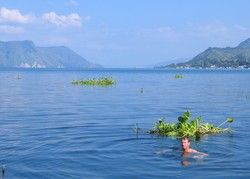 Lake Toba: Sumatras main tourist attraction is the
vast crater lake Lake Toba. About 88000 yeas ago, a huge volcano errupted,
finally collapsed and created Lake Toba. Lake Toba is with its 1707
kmē the bigges lake in Southeast Asia and up to 450m deep. Samosir,
the island in Lake Toba is nearly as big as Singapore. Lake Toba,
already on an altitude of 900m and surrouded by huge mountains is
really very impresive, and so we spent a couple of days on Samosir.
For 2,- a day, we had a small and very beautiful bungalow with private
access to the lake. Lake Toba: Sumatras main tourist attraction is the
vast crater lake Lake Toba. About 88000 yeas ago, a huge volcano errupted,
finally collapsed and created Lake Toba. Lake Toba is with its 1707
kmē the bigges lake in Southeast Asia and up to 450m deep. Samosir,
the island in Lake Toba is nearly as big as Singapore. Lake Toba,
already on an altitude of 900m and surrouded by huge mountains is
really very impresive, and so we spent a couple of days on Samosir.
For 2,- a day, we had a small and very beautiful bungalow with private
access to the lake. |
| |
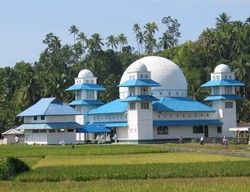 Muslims: During our trip, we have visited 10 muslim
countries, and have spent nearly one year in the muslim world. So
far we just talked about our good experiences and especially the great
hospitalety in Iran. A phenomenon we realized is, that it seems that
the Muslims are either very good and friendly (normally the very religious
people) or very unfriendly. Normal people, in Europe the majority,
are quite seldom. Because of this, we had most of our best and most
of our worst experiences with Muslim. Very unpleasant are the men,
who don't know how to behalf towards woman. Though we always said,
that we're married, and Nadine was dressed conservative, men regulary
tried to turn on Nadine indecent. We had men who started to grasp
her breasts or tried to kiss her. Once we were even attaked from three
guys on a moped, but we had good luck and some locals hepled us. In
our opinion, the reason for this bad behaviour is the misinterpretation
of the Quran, where woman and men have equal rights.The Arabs probably
were afraid of strong woman, and forced them to wear a scarf. Another
reason why woman have to wear a scarf seems to be, that the men don't
turst each other. They fear, that her wife could be molested form
another man, if she wouldn't wear a scarf. The domination of men is
also quite obvious in the upbringing of the children. While already
young girls have to work very hard in the household (e.g. carrying
water), the boys are often allowed to do whatever they want and normally
they don't learn to accept boundaries. The boys don't get boundaries
from their father, because they are his whole pride, and also not
from their mother, because otherwise she would get problems with her
husband if her son would tell it his fahter. We realized this phenomenon
also in Indonesia, although woman normally don't wear a scarf. May
be, we're a bit too sensitive, but we don't feel well, if people throw
stones to us or if they shout "Fuck You" to us (Nadine). We really
enjoyed the great hospitalety and the friendly people in Iran, Syria
and Turkey, but we're also happy to finally leave the islamic world
after Indonesia. Muslims: During our trip, we have visited 10 muslim
countries, and have spent nearly one year in the muslim world. So
far we just talked about our good experiences and especially the great
hospitalety in Iran. A phenomenon we realized is, that it seems that
the Muslims are either very good and friendly (normally the very religious
people) or very unfriendly. Normal people, in Europe the majority,
are quite seldom. Because of this, we had most of our best and most
of our worst experiences with Muslim. Very unpleasant are the men,
who don't know how to behalf towards woman. Though we always said,
that we're married, and Nadine was dressed conservative, men regulary
tried to turn on Nadine indecent. We had men who started to grasp
her breasts or tried to kiss her. Once we were even attaked from three
guys on a moped, but we had good luck and some locals hepled us. In
our opinion, the reason for this bad behaviour is the misinterpretation
of the Quran, where woman and men have equal rights.The Arabs probably
were afraid of strong woman, and forced them to wear a scarf. Another
reason why woman have to wear a scarf seems to be, that the men don't
turst each other. They fear, that her wife could be molested form
another man, if she wouldn't wear a scarf. The domination of men is
also quite obvious in the upbringing of the children. While already
young girls have to work very hard in the household (e.g. carrying
water), the boys are often allowed to do whatever they want and normally
they don't learn to accept boundaries. The boys don't get boundaries
from their father, because they are his whole pride, and also not
from their mother, because otherwise she would get problems with her
husband if her son would tell it his fahter. We realized this phenomenon
also in Indonesia, although woman normally don't wear a scarf. May
be, we're a bit too sensitive, but we don't feel well, if people throw
stones to us or if they shout "Fuck You" to us (Nadine). We really
enjoyed the great hospitalety and the friendly people in Iran, Syria
and Turkey, but we're also happy to finally leave the islamic world
after Indonesia. |
| |
 Crossing the Equator: After 25850 km and
329 days, we crossed the Equator in Indonesia. Crossing the Equator
and taking a picture is only allowed for tourists after having purchased
a ticket for the nearby museum. Because we had no ticked and because
we were not willing to by one, this strange guy protected the monument
from my camera! Crossing the Equator: After 25850 km and
329 days, we crossed the Equator in Indonesia. Crossing the Equator
and taking a picture is only allowed for tourists after having purchased
a ticket for the nearby museum. Because we had no ticked and because
we were not willing to by one, this strange guy protected the monument
from my camera! |
| |
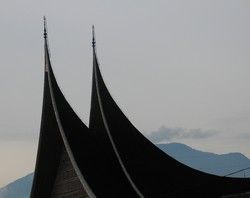 Corruption: Corruption is wide spread in
Indonesia and quite often, we met Indonesian, claiming the corrupt
officials (especially the police) and politicans. In Indonesia you
have to bribe the officials to get a job from the government. Even
for simple jobs in the army, bribe is necesarry. But corruption is
a big problem all over Indonesia, because even in the smallest store
the prices are rising, if tourists are the customers. We talked once
quite a while with a young man. He had graduaded at university, but
because he couldn't afford the bribe, he's unemployd and survives
from several small jobs. We were sitting in the small restaurant of
one of his relatives and drank a Coke while talking. Finally we had
to pay the double price for the Coke. Nadine tried to explain our
conversation partner, that this is very similar to corruption and
not much better, but he was not willing to understand this. We have
the feeling, that corruption is not really a problem in Indonesia,
because nearly everybody is involved (at least if they see tourists).
But there are of course also many honest people. Corruption: Corruption is wide spread in
Indonesia and quite often, we met Indonesian, claiming the corrupt
officials (especially the police) and politicans. In Indonesia you
have to bribe the officials to get a job from the government. Even
for simple jobs in the army, bribe is necesarry. But corruption is
a big problem all over Indonesia, because even in the smallest store
the prices are rising, if tourists are the customers. We talked once
quite a while with a young man. He had graduaded at university, but
because he couldn't afford the bribe, he's unemployd and survives
from several small jobs. We were sitting in the small restaurant of
one of his relatives and drank a Coke while talking. Finally we had
to pay the double price for the Coke. Nadine tried to explain our
conversation partner, that this is very similar to corruption and
not much better, but he was not willing to understand this. We have
the feeling, that corruption is not really a problem in Indonesia,
because nearly everybody is involved (at least if they see tourists).
But there are of course also many honest people. |
| |
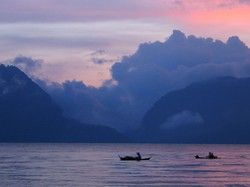 Lake Manijau: After some tough days on
the Trans Sumatra Highway (hot, humit, many moutains, many kilometers)
we took some days off at Lake Manijau. Like Lake Toba, Lake Manijau
is also the reminder of a former volcano. Although much smaller than
Lake Toba, it's so big, that you have to cycle 70 km to surround it.
We spent our days in a lovely small bungalow, direkt on the beach
with swimming and reading. The lake is also surrounded by big mountains,and
because we were already very close to the ocean, big clouds came in
each evening. Especially the big thunderstorm clouds were very impressive. Lake Manijau: After some tough days on
the Trans Sumatra Highway (hot, humit, many moutains, many kilometers)
we took some days off at Lake Manijau. Like Lake Toba, Lake Manijau
is also the reminder of a former volcano. Although much smaller than
Lake Toba, it's so big, that you have to cycle 70 km to surround it.
We spent our days in a lovely small bungalow, direkt on the beach
with swimming and reading. The lake is also surrounded by big mountains,and
because we were already very close to the ocean, big clouds came in
each evening. Especially the big thunderstorm clouds were very impressive.
|
| |
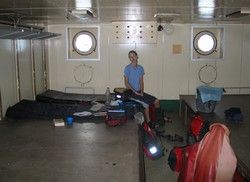 Boat trip: To cycle the entire island,
Sumatra is much to big for the two months visa. There are trains just
in the very east of Sumatra, and a 30 hour bus trip on the Trans Sumatra
Highway is really tough, so we decided to sail by ferryboat from Padang
to Jakarta. Although the ticketoffice was also open on sunday, we
couldn't by a ticket, because they were not able to make a photocopy
of our passport. The ferryboat departs each fortnight, and 3 hours
before departure, we finally got our tickets. There were no problems
with the bicycles, but we had to carry them over steep stairs into
the boat. Food was included in the two days trip, and we had just
left the habour, when we got our first lunch: rice with fish. The
menue was quite simple: rice and fish for lunch and dinner and rice
and fried eggs for breakfast. We travelled in "Ekonomi klas", and
so we stayed with 300 other passengers on a big deck. The deck was
like a very big dormitory with always 7 beds in one row. We managed
to find a quite silent corner, although due to the roaring televison,
it was not really silent. We spent the afternoon at the fresh air
and when we came back, we returned into a smoking cave. Despite the
"No smoking" signs, quit a lot of men were smoking and it was no fun
to breath the hot, humid and smokie air. We asked some of the smokers
to smoke outside, but of course they didn't care. Then I asked one
of the crew members at the information desk for assistance. The crew
member inspected to deck, but because there were too many smokers,
he was afraid of them and so he offered us to change to another deck.
The other deck was completely emty, silent, and much cooler (although
still over 30°C). We moved and spent our last 1,5 days in a big "private
suite". Boat trip: To cycle the entire island,
Sumatra is much to big for the two months visa. There are trains just
in the very east of Sumatra, and a 30 hour bus trip on the Trans Sumatra
Highway is really tough, so we decided to sail by ferryboat from Padang
to Jakarta. Although the ticketoffice was also open on sunday, we
couldn't by a ticket, because they were not able to make a photocopy
of our passport. The ferryboat departs each fortnight, and 3 hours
before departure, we finally got our tickets. There were no problems
with the bicycles, but we had to carry them over steep stairs into
the boat. Food was included in the two days trip, and we had just
left the habour, when we got our first lunch: rice with fish. The
menue was quite simple: rice and fish for lunch and dinner and rice
and fried eggs for breakfast. We travelled in "Ekonomi klas", and
so we stayed with 300 other passengers on a big deck. The deck was
like a very big dormitory with always 7 beds in one row. We managed
to find a quite silent corner, although due to the roaring televison,
it was not really silent. We spent the afternoon at the fresh air
and when we came back, we returned into a smoking cave. Despite the
"No smoking" signs, quit a lot of men were smoking and it was no fun
to breath the hot, humid and smokie air. We asked some of the smokers
to smoke outside, but of course they didn't care. Then I asked one
of the crew members at the information desk for assistance. The crew
member inspected to deck, but because there were too many smokers,
he was afraid of them and so he offered us to change to another deck.
The other deck was completely emty, silent, and much cooler (although
still over 30°C). We moved and spent our last 1,5 days in a big "private
suite". |
| |
 Jakarta: After 2 days, we arraved
at Jakarta, the capital and economic center of Indonesia. The port
was 13 km outside the city, so we were facing the big challange "cycling
in the 10,5 mio. metropolis Jakarta. The traffic was absolutely horrible,
and the only working rule is "the stongest always has the right of
way". We decided to reduce the challange to a minimum and planned
to cycle just to the next railway station to catch a train to Yogyakarta.
There were no traffic signs, so we asked some people for the direction.
Conversation was not easy, the roads became smaller and smaller, and
finally we ende up in the slums of Jakarta. We had good luck and managed
to find a major road heading into the city center. The closer we came
into the city center, the more chaotic and dangerous became the traffic.
For many motorcyclist was the traffic too slow, so they decided to
drive on the sidewalk. After 16 km we arrived at the first railway
station, but no train was departing to Yogyakarta from here. While
cycling to the next railway station I was twice touched from a motorcycle
and a minibus, but nothing serious happened. In Indonesia there are
different railway stations for the different train classes, and from
the main railway station only the luxury andexpensive trains departed,
so we had to cycle to the third station. We had managed already 25
km in Jakarta's horrible traffic without any accident and were aonly
100m away from the third station, when a bus driver became cracy in
the traffic jam an bumbed into Nadines bike. Nadines bike layed half
below the bus, but she was not injured although the back wheel didn't
move anymore. In the eyes of the busdriver it was only a minor accident
and so he waved with his arms to show us to clear the road. Finally
the bus driver came out of his bus and offered us 0,83 damages for
the destroyed bike! While I tried to find a police officer, a young
man jumped out of another bus to protect Nadine and our bicycles,
because in the meanwhile the mob had surrounded her and some man even
started to molest her indecent. I managed to find a police officer,
but he was not really willing to come to the accident. He followed
me very slowly and had even enough time to ask the owners of some
fruitstalls afer the prices of apples! After ages we returned to Nadine,
but the bus driver had disappeared in the meanwhile. Nadines back
wheel stuck completely, so I had to carry her fully loaded bike to
the policestation (at least one passanger helped me a bit). No police
officer was able to speak English and it took some time, until they
had found someone who was able to translate. We told the police officers
what had happened and showed them the pictures of the bus and the
bus driver. Then they asked us the usual question: "And what shall
we do now?" We're already used to lazy officials and police officers,
and so we told them that we want them to write a report about the
accident. The officers dissapeared and I started to repair Nadines
bike. First I fixed the puncture and then I looked closer at the rest
of the bike. The bus had crashed into her rack and it was totally
deformed. With the help of a nearby workshop, I managed to fix the
rack, and I had just finished the essential repairs, when the police
officers returned with the report. Because we were tourists, they
told us, that they would send any further information to the German
embassy. Of course we don't expect to get some money for the broken
parts, but we didn't want to accept the accidet without any reaction.
At least we were really happy to see some police officers working
without bribe! Jakarta: After 2 days, we arraved
at Jakarta, the capital and economic center of Indonesia. The port
was 13 km outside the city, so we were facing the big challange "cycling
in the 10,5 mio. metropolis Jakarta. The traffic was absolutely horrible,
and the only working rule is "the stongest always has the right of
way". We decided to reduce the challange to a minimum and planned
to cycle just to the next railway station to catch a train to Yogyakarta.
There were no traffic signs, so we asked some people for the direction.
Conversation was not easy, the roads became smaller and smaller, and
finally we ende up in the slums of Jakarta. We had good luck and managed
to find a major road heading into the city center. The closer we came
into the city center, the more chaotic and dangerous became the traffic.
For many motorcyclist was the traffic too slow, so they decided to
drive on the sidewalk. After 16 km we arrived at the first railway
station, but no train was departing to Yogyakarta from here. While
cycling to the next railway station I was twice touched from a motorcycle
and a minibus, but nothing serious happened. In Indonesia there are
different railway stations for the different train classes, and from
the main railway station only the luxury andexpensive trains departed,
so we had to cycle to the third station. We had managed already 25
km in Jakarta's horrible traffic without any accident and were aonly
100m away from the third station, when a bus driver became cracy in
the traffic jam an bumbed into Nadines bike. Nadines bike layed half
below the bus, but she was not injured although the back wheel didn't
move anymore. In the eyes of the busdriver it was only a minor accident
and so he waved with his arms to show us to clear the road. Finally
the bus driver came out of his bus and offered us 0,83 damages for
the destroyed bike! While I tried to find a police officer, a young
man jumped out of another bus to protect Nadine and our bicycles,
because in the meanwhile the mob had surrounded her and some man even
started to molest her indecent. I managed to find a police officer,
but he was not really willing to come to the accident. He followed
me very slowly and had even enough time to ask the owners of some
fruitstalls afer the prices of apples! After ages we returned to Nadine,
but the bus driver had disappeared in the meanwhile. Nadines back
wheel stuck completely, so I had to carry her fully loaded bike to
the policestation (at least one passanger helped me a bit). No police
officer was able to speak English and it took some time, until they
had found someone who was able to translate. We told the police officers
what had happened and showed them the pictures of the bus and the
bus driver. Then they asked us the usual question: "And what shall
we do now?" We're already used to lazy officials and police officers,
and so we told them that we want them to write a report about the
accident. The officers dissapeared and I started to repair Nadines
bike. First I fixed the puncture and then I looked closer at the rest
of the bike. The bus had crashed into her rack and it was totally
deformed. With the help of a nearby workshop, I managed to fix the
rack, and I had just finished the essential repairs, when the police
officers returned with the report. Because we were tourists, they
told us, that they would send any further information to the German
embassy. Of course we don't expect to get some money for the broken
parts, but we didn't want to accept the accidet without any reaction.
At least we were really happy to see some police officers working
without bribe! |
| |
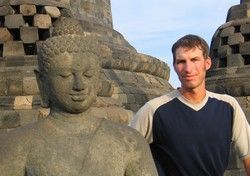 Borobudur: We took the night train to Yogyakarta,
the cultural center of Indonesia, and then cycled to Borobudur. Borobudur
is the biggest Buddhist temple in the southern hemisphere and was
built in 10th century, like the early temples of Ankor in Cambodia.
Even the architecture is quite similar. Borobudur means temple (Boro)
on a hill (budur). While the lower galeries have some beautiful carvings,
there are some meditating stone Buddhas below big stone bells on the
top galeries. There are only a few Buddhists in Indonesia and therefor
Borobudur is not used as a religious place any more. During the last
century, Borobudur was renovated twice. The second renovation between
1980 and 1988 was necesarry because underground water started to wash
out the fundament of the temple. Thanks to the 25 mio. US$ expensive
renovation, many generations will be able to visit Borobudur. Borobudur: We took the night train to Yogyakarta,
the cultural center of Indonesia, and then cycled to Borobudur. Borobudur
is the biggest Buddhist temple in the southern hemisphere and was
built in 10th century, like the early temples of Ankor in Cambodia.
Even the architecture is quite similar. Borobudur means temple (Boro)
on a hill (budur). While the lower galeries have some beautiful carvings,
there are some meditating stone Buddhas below big stone bells on the
top galeries. There are only a few Buddhists in Indonesia and therefor
Borobudur is not used as a religious place any more. During the last
century, Borobudur was renovated twice. The second renovation between
1980 and 1988 was necesarry because underground water started to wash
out the fundament of the temple. Thanks to the 25 mio. US$ expensive
renovation, many generations will be able to visit Borobudur. |
| |
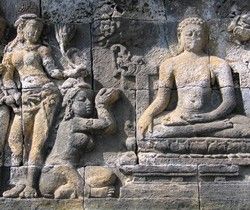 Buddha's live: There are carvings
on each galery of the Borobudur temple, but the carvings on the first
galerie are by far the most impressive. 120 reliefs show the most
important stages of Budhas live: Siddharta was born as a son of a
king. Siddharta looking for a bright. Siddhartas wedding and Siddharta
having a live without any sorrows in his palace. During three secret
trips, he saw an ill man, an old man a corpse and a monk. Siddharta
left his palace and became an asket. Siddharta became enlightened
and was named Gauthama Buddha. Buddha spent the rest of his live with
teaching. Buddha encouraged his students to prove everything, even
himself. Buddha's live: There are carvings
on each galery of the Borobudur temple, but the carvings on the first
galerie are by far the most impressive. 120 reliefs show the most
important stages of Budhas live: Siddharta was born as a son of a
king. Siddharta looking for a bright. Siddhartas wedding and Siddharta
having a live without any sorrows in his palace. During three secret
trips, he saw an ill man, an old man a corpse and a monk. Siddharta
left his palace and became an asket. Siddharta became enlightened
and was named Gauthama Buddha. Buddha spent the rest of his live with
teaching. Buddha encouraged his students to prove everything, even
himself. |
| |
 Mt. Bromo: The landscape around Mt. Bromo
(thesmall vulcanoe on the bottom left) is especially amazing during
sunrise. Many tourist hire a 4WD to drive to the tourist viewpoint,
but be made the 2 hours walking tour. Together with Tim and Evelien
from Belgium, we started at 3 pm. In the beginning it was no problem
to follow the sealed road in the clear and moonless night. But then
the sealed road became a small, narrow path. Sometimes the path was
completely covered with small bushes, but with our torches we did't
get lost. Aleady during the ascent we passed some great viewpoints,
and due to the silence in the early morning, it was a really amazing
mood. Shortly after sunrise we arrived on the tourist viewpoint and
were really shocked. Heeps of tourists, schouting and pushing each
other just to shoot the best photo. But all the other tourists were
on an though scedule, and 30 minutes they all went back to their 4WD
and rushed to the next spot. Mt. Bromo: The landscape around Mt. Bromo
(thesmall vulcanoe on the bottom left) is especially amazing during
sunrise. Many tourist hire a 4WD to drive to the tourist viewpoint,
but be made the 2 hours walking tour. Together with Tim and Evelien
from Belgium, we started at 3 pm. In the beginning it was no problem
to follow the sealed road in the clear and moonless night. But then
the sealed road became a small, narrow path. Sometimes the path was
completely covered with small bushes, but with our torches we did't
get lost. Aleady during the ascent we passed some great viewpoints,
and due to the silence in the early morning, it was a really amazing
mood. Shortly after sunrise we arrived on the tourist viewpoint and
were really shocked. Heeps of tourists, schouting and pushing each
other just to shoot the best photo. But all the other tourists were
on an though scedule, and 30 minutes they all went back to their 4WD
and rushed to the next spot. |
| |
 Smoking Mt. Bromo: The volcano
Mt. Bromo is still active and, although normally very quiet, 2 tourist
died some years ago drung a small eruption.We climbed to the rim of
Mt. Bromo but the view inside the volcanoe was not very exiting. MT.
Bromo was just smoking in silence. Smoking Mt. Bromo: The volcano
Mt. Bromo is still active and, although normally very quiet, 2 tourist
died some years ago drung a small eruption.We climbed to the rim of
Mt. Bromo but the view inside the volcanoe was not very exiting. MT.
Bromo was just smoking in silence. |
| |
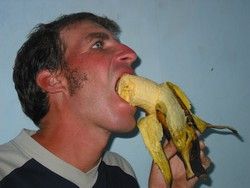 Giant bananas: We already saw some of these
huge bananas in Malaysia, but we thouht that they are used for cooking
or making beer. We saw the bananas again in Indonesia and bought immediately
one. The banana was so huge, that it was as long as my forearm and
so thick, that I was just able to open my mouth wide enough, to bite
off a piece. The giant banana tasted like a normal banana and it was
enough for Nadine and me for breakfast. Giant bananas: We already saw some of these
huge bananas in Malaysia, but we thouht that they are used for cooking
or making beer. We saw the bananas again in Indonesia and bought immediately
one. The banana was so huge, that it was as long as my forearm and
so thick, that I was just able to open my mouth wide enough, to bite
off a piece. The giant banana tasted like a normal banana and it was
enough for Nadine and me for breakfast. |
| |
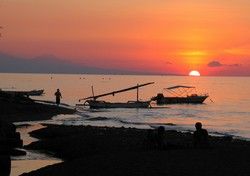 The wrack of USS Liberty (Bali): One of the most famous
dive spots on Bali is the wreck of the USS Liberty. The USS Liberty,
an US cargoboat, was targeted by a torpedo in 19942 during WWII and
towed to the beach of Tulamben. After the vulcano Mt. Anung erupted
in 1963, the Liberty finally sunk. Since then, the Liberty is lying
about 25m offshore in a depth of 5m - 30m. As soon as the Liberty
was on the ground, many corals and fish made it their new home. I
allowed me two dives, and although my divemaster was nor motivated
at all, it was very fascinating to dive through the wreck. Behind
each corner, a new surprise was waiting for me, and I even saw a tiny
seahorse. Good luck, the Liberty sunk some years after it was hit
by the torpedo, so I didnīt have the feeling to visit a underwater
cementery. The wrack of USS Liberty (Bali): One of the most famous
dive spots on Bali is the wreck of the USS Liberty. The USS Liberty,
an US cargoboat, was targeted by a torpedo in 19942 during WWII and
towed to the beach of Tulamben. After the vulcano Mt. Anung erupted
in 1963, the Liberty finally sunk. Since then, the Liberty is lying
about 25m offshore in a depth of 5m - 30m. As soon as the Liberty
was on the ground, many corals and fish made it their new home. I
allowed me two dives, and although my divemaster was nor motivated
at all, it was very fascinating to dive through the wreck. Behind
each corner, a new surprise was waiting for me, and I even saw a tiny
seahorse. Good luck, the Liberty sunk some years after it was hit
by the torpedo, so I didnīt have the feeling to visit a underwater
cementery. |
| |
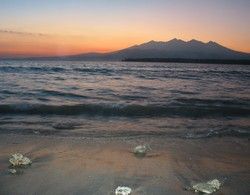 Gilli Air on Lombok: The Island east of Bali is Lombock,
and some kilometers off-shore from Lombok are the three small Gilli
Islands. The Gilli Islands, with beautiful palms, beaches, coral reefs
close to the shore and without cars or mopeds, are one of the best
spots in Indonesia and not very well known. But even here, the best
years are already gone. Since the 1998 El Nino the coral reefs lost
most of their colours and there are not many fish to spot, in contrast
to touts. Although it was not as good as Koh Tao (Thailand) and the
Perhentian Islands (Malaysia), we enjoyed Gilli Air. We had good luck
and found a small bungalow with ocean view and spent our days with
snorkeling and reading. Gilli Air on Lombok: The Island east of Bali is Lombock,
and some kilometers off-shore from Lombok are the three small Gilli
Islands. The Gilli Islands, with beautiful palms, beaches, coral reefs
close to the shore and without cars or mopeds, are one of the best
spots in Indonesia and not very well known. But even here, the best
years are already gone. Since the 1998 El Nino the coral reefs lost
most of their colours and there are not many fish to spot, in contrast
to touts. Although it was not as good as Koh Tao (Thailand) and the
Perhentian Islands (Malaysia), we enjoyed Gilli Air. We had good luck
and found a small bungalow with ocean view and spent our days with
snorkeling and reading. |
| |
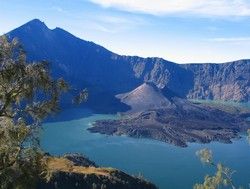 Mt. Rinjani trekking tour (Lombok):
One of the highlights of Lombok is a trekking tour in the Mt. Rinjani
nationalpark. The volcanoe Mt. Rinjani, with its 3700m is the second
highest mountain in Indonesia, and is best expolred on a 3 days 2
nights trekking tour. While most of the tourist climb the mountain
on a arranged tour, we did it on our own. On the first day, we climbed
to the first rim at 2645m. Iīve already been quite often in the mountains,
but I never had an ascent of 2200m in one day, and so I was quite
surprised, how easy it was. The last water source was a small puddle
(during the rain season a small creek) on 2000m, so we had to carry
our water to the rim. During sunset, the view of Mt. Rinjani, and
the crater lake was amazing. After sunset we tried to warm up with
some other tourists around a small fire, before we went into our sleepingbags.
On the second day, we descended to the lake and planned to stay there
for the second night. But there was so much rubbish around the lake,
that we took just a small bath in a thermal spring, before we returned
back to the rim. Our second night was pretty cold; it was freezing!!!
Already during the descend to the crater lake, Nadines knee started
to ache, so we didnīt climb Mt. Rinjani and went back into the valley
on the third day. Mt. Rinjani trekking tour (Lombok):
One of the highlights of Lombok is a trekking tour in the Mt. Rinjani
nationalpark. The volcanoe Mt. Rinjani, with its 3700m is the second
highest mountain in Indonesia, and is best expolred on a 3 days 2
nights trekking tour. While most of the tourist climb the mountain
on a arranged tour, we did it on our own. On the first day, we climbed
to the first rim at 2645m. Iīve already been quite often in the mountains,
but I never had an ascent of 2200m in one day, and so I was quite
surprised, how easy it was. The last water source was a small puddle
(during the rain season a small creek) on 2000m, so we had to carry
our water to the rim. During sunset, the view of Mt. Rinjani, and
the crater lake was amazing. After sunset we tried to warm up with
some other tourists around a small fire, before we went into our sleepingbags.
On the second day, we descended to the lake and planned to stay there
for the second night. But there was so much rubbish around the lake,
that we took just a small bath in a thermal spring, before we returned
back to the rim. Our second night was pretty cold; it was freezing!!!
Already during the descend to the crater lake, Nadines knee started
to ache, so we didnīt climb Mt. Rinjani and went back into the valley
on the third day. |
| |
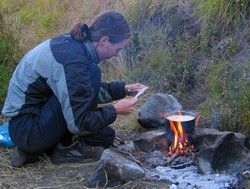 Cooking adventures: We had not enough space
in our rucksacks to take our stove with us, and so we had to cook
on a fire. Even if its more romantic to cook on a real fire, we didnīt
fell in love with it. Our fire was smoking quite a lot because we
had just some small wet peaces of wood and we and our clothes smelled
very smoky afterward. Although we just made a noodlesoup our pot was
completly black and it took Nadine neraly 30 minutes to clean it. Cooking adventures: We had not enough space
in our rucksacks to take our stove with us, and so we had to cook
on a fire. Even if its more romantic to cook on a real fire, we didnīt
fell in love with it. Our fire was smoking quite a lot because we
had just some small wet peaces of wood and we and our clothes smelled
very smoky afterward. Although we just made a noodlesoup our pot was
completly black and it took Nadine neraly 30 minutes to clean it. |
| |
 Hot Springs (Mt. Rinjani): The area
around the original hot springs is used from some locals for living
and so it looked like a big dump. Thatīs why all the guides tell their
tourists, that the water is much too hot there and the best spot is
further down the hot river. But some other guests thought, that the
tourist pool is a toilet and so it was a real unforgettable experience,
to bath in the pool with some decent smell of excrements in the air. Hot Springs (Mt. Rinjani): The area
around the original hot springs is used from some locals for living
and so it looked like a big dump. Thatīs why all the guides tell their
tourists, that the water is much too hot there and the best spot is
further down the hot river. But some other guests thought, that the
tourist pool is a toilet and so it was a real unforgettable experience,
to bath in the pool with some decent smell of excrements in the air. |
| |
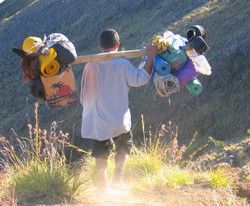 Porters: All the tourist tours a acompanied
by a tourguide and a porter. While the tour guide is carrying the
resposibility, the porter has to carry the tent, kitchen gear, the
food and of curse all the water (tourist donīt drink water from a
puddle). Quite a lot of stuff for 4 persons (2 tourists + guide +
porter). For us it was always amazing to see what the porters were
carrying to the top of the mountain: several pinnapples, a whole bundle
of bananas, tea, coffee, hot chocolate, chips, cookies, chicken wings
or even living chicken (on the left side of the porter). But instead
of carrying everything in a rucksack, they arraged everything to bundles
and fixed it to a bamboo stick (the normal way of transporting things
in Souteast Asia). How the porters managed to carry everything over
the steep paths with even some climbing sections is still a miracle
for us. The best of all is, that they managed to carry their heavy
load (much more than 40 Kg) in an altitude of 2500m while wearing
flip-flops instead of propper shoes!!! Porters: All the tourist tours a acompanied
by a tourguide and a porter. While the tour guide is carrying the
resposibility, the porter has to carry the tent, kitchen gear, the
food and of curse all the water (tourist donīt drink water from a
puddle). Quite a lot of stuff for 4 persons (2 tourists + guide +
porter). For us it was always amazing to see what the porters were
carrying to the top of the mountain: several pinnapples, a whole bundle
of bananas, tea, coffee, hot chocolate, chips, cookies, chicken wings
or even living chicken (on the left side of the porter). But instead
of carrying everything in a rucksack, they arraged everything to bundles
and fixed it to a bamboo stick (the normal way of transporting things
in Souteast Asia). How the porters managed to carry everything over
the steep paths with even some climbing sections is still a miracle
for us. The best of all is, that they managed to carry their heavy
load (much more than 40 Kg) in an altitude of 2500m while wearing
flip-flops instead of propper shoes!!! |
| |
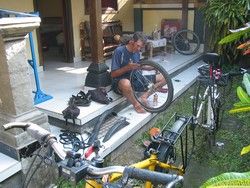 The big cleaning: Australia has some strict
quarantaine laws, because they donīt want to import any disease from
the rest of the world and especially not from Asia. If you arrive
in Australie all your equipment, and especially bicycles are inspected
very serious. To avoid trouble, we decided to clean our bicycles and
our whole equipmen. It took us about two days to clean the bikes,
but now our they look like brand new! The big cleaning: Australia has some strict
quarantaine laws, because they donīt want to import any disease from
the rest of the world and especially not from Asia. If you arrive
in Australie all your equipment, and especially bicycles are inspected
very serious. To avoid trouble, we decided to clean our bicycles and
our whole equipmen. It took us about two days to clean the bikes,
but now our they look like brand new! |
| |
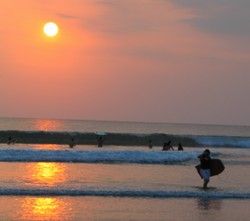 "Kuta, the paradise!?": We spent our last
two dayīs in Indonesia in Kuta, a big beach resort and the main tourist
spot in Bali. For us already Koh Samui (Thailand) was a bit too busy,
but Kuta was realy though. One surfshop next to each other and even
during the night it never became silent. Many tourists from Australia
travel to Kuta especially for surfing. Because the surf guards were
too busy to look after the girls, I had to rescue twice an indonesian
guy, who was caught by the current and disappeared to the open sea.
The guy had borrowed a bodyboard, and because he was not able to swim
he was helpless, when he was cought from the current. Apart from some
trips to the beach, we spent most of the day with cleaning our equipment
or reading our books (to bee able to exchange them in Indonesia).
On June 05. 2005 we flew from Denpasar to Darwin in Australia. "Kuta, the paradise!?": We spent our last
two dayīs in Indonesia in Kuta, a big beach resort and the main tourist
spot in Bali. For us already Koh Samui (Thailand) was a bit too busy,
but Kuta was realy though. One surfshop next to each other and even
during the night it never became silent. Many tourists from Australia
travel to Kuta especially for surfing. Because the surf guards were
too busy to look after the girls, I had to rescue twice an indonesian
guy, who was caught by the current and disappeared to the open sea.
The guy had borrowed a bodyboard, and because he was not able to swim
he was helpless, when he was cought from the current. Apart from some
trips to the beach, we spent most of the day with cleaning our equipment
or reading our books (to bee able to exchange them in Indonesia).
On June 05. 2005 we flew from Denpasar to Darwin in Australia. |
| |
|
|
I
BOOKLET
available
for
DONATION!

50pages, 80 b/w photos, background
infos, stories, ...
Just send your donation
to our
Pay
Pal account: nadinepuschkasch@yahoo.de
and email us your post
address and we´ll send it to you.
|
| |
| |
|
Like to place your Ad here?
Just e-mail to:
martinlunz@yahoo.de
|
| |
| |
|
You
liked our website and like to contribute?
Our Pay
Pal account is: nadinepuschkasch@yahoo.de
|
|
| |
|
